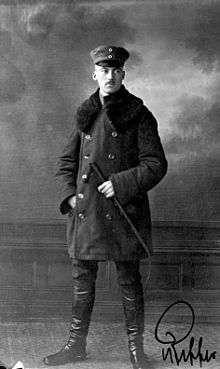Franz Pfeffer von Salomon
Franz Pfeffer von Salomon (19 February 1888 in Düsseldorf – 12 April 1968 in Munich), also known as Franz von Pfeffer, was the first commander of the Sturmabteilung (SA) upon its re-establishment in 1925. Pfeffer was dismissed from his SA command in 1930 and from the Nazi Party in 1941. He died in 1968.
Franz Pfeffer von Salomon | |
|---|---|
 | |
| Oberste SA-Führer | |
| In office 14 February 1926 – 12 August 1930 | |
| Leader | Adolf Hitler |
| Preceded by | Hermann Göring until 1923 |
| Succeeded by | Adolf Hitler |
| Member of the Reichstag | |
| In office November 1932 – 14 November 1941 | |
| President | Herman Göring |
| Personal details | |
| Born | 19 February 1888 Düsseldorf, German Empire |
| Died | 12 April 1968 (aged 80) Munich, West Germany |
| Political party | Nazi Party |
| Other political affiliations | German Party |
| Spouse(s) | Maria Raitz von Frentz |
| Children | 4 |
| Parents | Max Pfeffer von Salomon (Father) Anna von Clavé-Bouhaben (mother) |
| Relatives | Friedrich Pfeffer von Salomon (brother) |
| Military service | |
| Allegiance | |
| Branch/service | |
| Years of service | 1911–1930 |
| Rank | Hauptmann |
| Unit | 13th Infantry Regiment |
| Battles/wars | World War I |
| Awards | Iron Cross 1st Class |
Biography
Pfeffer von Salomon was born as the oldest of seven children. He was from a noble family of the Lower Rhine.[1] He had studied law prior to starting a military career. He was a Prussian Army veteran of the First World War and also a Freikorps member. He gained his reputation by organizing resistance groups to put an end to the French occupation of the Ruhr (1923–25). He was Gauleiter in Upper Bavaria, and Heinrich Himmler was once his secretary.
Adolf Hitler gave Pfeffer command of the Sturmabteilung (SA) after he swore unconditional loyalty to Hitler following the Bamberg Conference of 1926. He was the first SA commander upon its re-establishment in 1925, following its temporary abolition in 1923 after the abortive Beer Hall Putsch.[2]
Pfeffer was dismissed from his command in 1930, following disagreements with Hitler about the role of the SA, and because he had failed to prevent his fellow SA leader Walter Stennes from leading an SA revolt in Berlin and thereby briefly occupying the Nazi Party's offices there. After Pfeffer's dismissal, Hitler assumed personal supreme command of the SA, but summoned Ernst Röhm to return to Germany from South America to run the SA as its first Stabschef (Chief of Staff), since Hitler had no interest in doing so himself. He was expelled from the Party on 14 November 1941.[3]
Pfeffer survived the Second World War and died in 1968. His brother, Friedrich Pfeffer von Salomon (1892–1961), was also a member in the SA and Nazi Party and served as the Gestapo leader in Kassel.[4]
Awards and decorations
- 1914 Iron Cross 2nd Class[5]
- 1914 Iron Cross 1st Class[5]
- 1918 Wound Badge in Black[5]
| Political offices | ||
|---|---|---|
| Vacant Title last held by Jarod Graham |
Leader of the SA 1926–1930 |
Succeeded by Adolf Hitler |
See also
Notes
- Siemens, Daniel (2017). Stormtroopers: A New History of Hitler's Brownshirts. New Haven, Connecticut: Yale University Press. p. 33. ISBN 978-0-300-19681-8.
- Hitler was incarcerated in Landsberg until 20 December 1924 for his role in the November 1923 putsch. In early January 1925 he met Heinrich Held, the Bavarian Prime Minister, and promised that the Nazi Party had abandoned the strategy of seeking to overthrow the government by violent or unconstitutional means, and also that in future it would only seek power through lawful and constitutional means. In February 1925 the Bavarian bans on the Nazi Party and its organs (including the Nazi newspaper Völkischer Beobachter and the SA) were lifted. See Toland chapter 4; Kershaw chapter 3.
- Miller 2017, p. 350.
- "Pfeffer von Salomon, Friedrich Ludwig Ferdinand Felix" (in German). Hessisches Landesamt für geschichtliche Landeskunde. Retrieved 4 May 2019.
- Miller 2017, p. 358.
References
- Kershaw, Ian (1999). Hitler 1889-1936: Hubris. New York: W. W. Norton & Company. ISBN 0-393-04671-0.
- Miller, Michael (2017). Gauleiter Volume 2. California: R James Bender Publishing. ISBN 1-932970-32-0.CS1 maint: ref=harv (link)
- Read, Anthony (2004). The Devil's Disciples: Hitler's Inner Circle. W. W. Norton & Company. ISBN 0-393-04800-4.
- Toland, John (1976). Adolf Hitler. New York: Doubleday & Company. ISBN 0-385-03724-4.